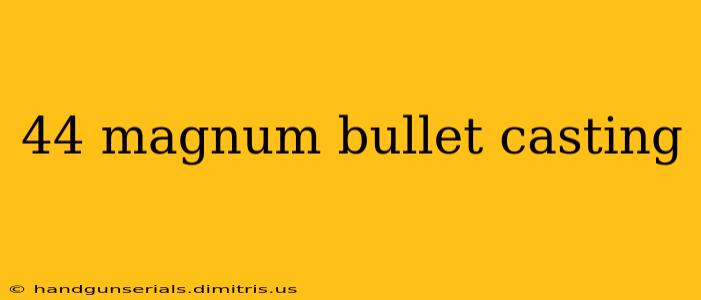Casting your own 44 Magnum bullets offers significant advantages to the serious reloader: cost savings, the ability to customize bullet designs, and the satisfaction of creating your own ammunition. However, it's a process requiring precision and attention to detail. This guide provides a comprehensive overview of the process, covering everything from selecting your alloy to final bullet sizing.
Choosing Your Alloy: The Foundation of a Good Bullet
The alloy you select significantly impacts the performance and accuracy of your 44 Magnum bullets. Common choices include:
- Linotype: A readily available and relatively inexpensive alloy, linotype is known for its hardness and good casting characteristics. It's a popular choice for many calibers, including the .44 Magnum.
- Wheel Weights: Recycled wheel weights offer a cost-effective alternative, but their composition can be inconsistent. Testing is crucial to determine the hardness and suitability for your specific application. Important Note: Always ensure you are using lead-based wheel weights, not zinc-based.
- Pure Lead: While soft, pure lead casts easily and is excellent for testing different bullet designs. However, its softness limits its suitability for high-velocity applications like the .44 Magnum. It's often used as a base to which harder alloys are added.
- Alloy Blends: Many reloaders experiment with alloy blends to achieve specific hardness and performance characteristics. This often involves adding tin or antimony to pure lead or wheel weights to improve hardness and reduce leading.
Determining Hardness: A lead hardness tester is invaluable for ensuring your alloy meets the requirements for your intended use. Proper hardness is critical for preventing leading in the barrel.
Setting Up Your Casting Equipment
Successful bullet casting requires the right equipment:
- Melting Pot: Choose a pot appropriate for the volume of alloy you'll be melting. Electric pots offer better temperature control.
- Ladle: A sturdy ladle is essential for pouring the molten lead into your molds.
- Molds: 44 Magnum molds are readily available in various designs, allowing you to cast bullets with different weights, shapes, and styles. Consider your intended application (hunting, target shooting, etc.) when selecting your molds.
- Thermometer: Accurate temperature control is crucial for consistent bullet casting. A reliable thermometer will help you maintain the optimal temperature for your chosen alloy.
- Safety Gear: Safety is paramount. Always wear safety glasses, gloves, and appropriate clothing to protect yourself from molten lead splashes and fumes. Work in a well-ventilated area.
The Casting Process: A Step-by-Step Guide
- Prepare Your Alloy: Clean and sort your alloy, removing any contaminants. Melt the alloy slowly and carefully in your melting pot.
- Temperature Control: Maintain the molten lead at the optimal temperature for your alloy, typically between 650-750°F (343-399°C). Refer to your alloy's specifications for the precise temperature range.
- Mold Preparation: Lightly lubricate your molds with a mold release agent to prevent sticking and ensure clean bullet release.
- Pouring: Carefully ladle the molten lead into the molds, ensuring complete filling.
- Cooling: Allow the bullets to cool completely before removing them from the molds.
- Cleaning and Sizing: Remove any flashing or imperfections from the bullets and size them to the correct diameter using a sizing die. This ensures they fit properly in your cases.
Bullet Design Considerations for 44 Magnum
The shape and weight of your bullet will impact its ballistic performance. Common designs include:
- Round Nose: A simple, versatile design suitable for target shooting and plinking.
- Flat Nose: Offers increased stopping power at shorter ranges.
- Wadcutter: Used primarily for target shooting, producing clean cuts in paper targets.
- Hollow Point: Designed to expand upon impact, increasing stopping power in hunting applications.
Beyond the Basics: Advanced Techniques and Considerations
- Gas Checks: For higher-velocity loads, gas checks help to prevent leading.
- Alloy experimentation: Fine-tuning your alloy composition can significantly improve accuracy and reduce leading.
- Bullet Lubrication: Proper lubrication can enhance accuracy and reduce friction.
Casting your own 44 Magnum bullets is a rewarding process that provides significant benefits to the dedicated reloader. However, remember that safety and precision are paramount. Thorough research and careful attention to detail are essential for achieving consistent, high-quality results. Always consult reputable reloading manuals and adhere to safe reloading practices.

